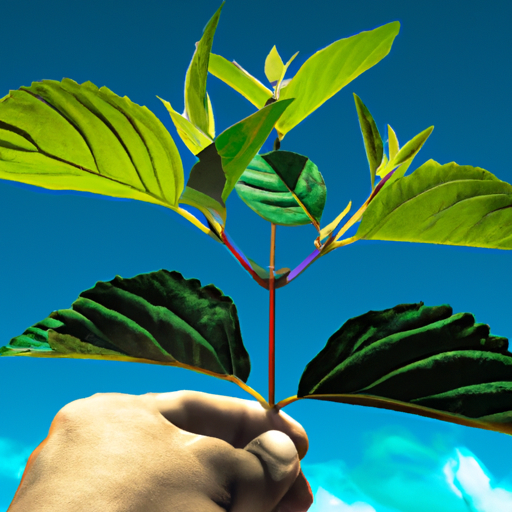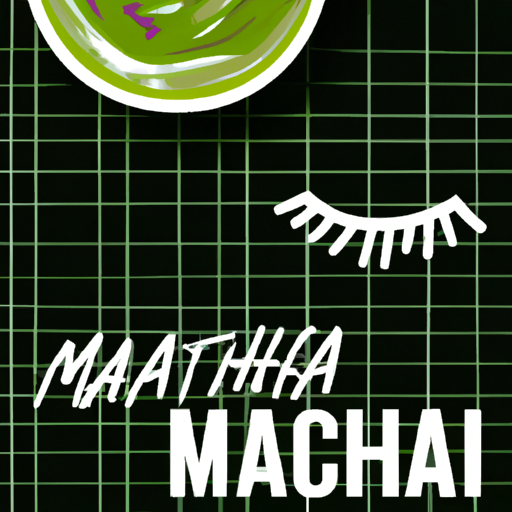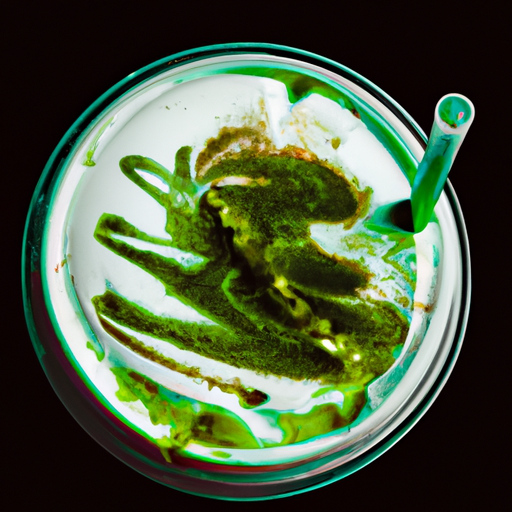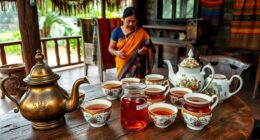I’m a huge admirer of matcha, a brilliantly green powder mixed with hot water to make a tasty and healthful drink. However, have you ever thought about the origins of matcha?
In this article, I will take you on a journey through the origins, cultivation, harvesting, and processing of matcha, and explore its rich history and cultural significance.
Matcha is a type of green tea that originated in China during the Tang Dynasty (618-907 CE), and was later brought to Japan by Buddhist monks in the 12th century. Over time, the Japanese developed their own unique methods for growing, harvesting, and processing matcha, which resulted in a higher quality and more vibrant green tea powder.
Today, matcha is widely consumed in Japan and around the world, and is known for its numerous health benefits, including high levels of antioxidants, vitamins, and minerals. So let’s dive deeper into the world of matcha and discover where this beloved beverage comes from.
Key Takeaways
- Matcha originated in China during the Tang Dynasty and was later brought to Japan by Buddhist monks.
- The Japanese developed their own unique methods for growing, harvesting, and processing matcha, resulting in higher quality and more vibrant green tea powder.
- The cultivation of matcha requires shading the plants to increase chlorophyll content and decrease bitterness, and harvesting techniques play a vital role in the quality of matcha.
- Matcha has been cultivated and consumed in Japan for over 800 years and has become an integral part of their culture, with a history closely tied to samurai warriors and their tea ceremonies.
The Origins of Matcha
You might be surprised to learn that matcha actually originated in China, but it was the Japanese who perfected the cultivation and preparation of this beloved green tea.
The origins of matcha can be traced back to the Tang Dynasty in China (618-907 AD), where tea leaves were ground into a powder and used for medicinal purposes.
It wasn’t until the 12th century, during the Song Dynasty, that matcha was introduced to Japan by Buddhist monks who had traveled to China to study.
The history of matcha in Japan is closely tied to the samurai warriors and their tea ceremonies. The samurai were known for their love of matcha, which provided them with the energy and focus needed for battle.
Matcha became an important part of Japanese culture and was eventually adopted by the ruling class. The cultivation and preparation of matcha were refined over the centuries, and by the 16th century, it had become the tea of choice for the Japanese elite.
The popularity of matcha continued to grow, and by the 19th century, it had become a staple in Japanese households. Today, matcha is enjoyed all over the world, and its popularity shows no signs of slowing down.
But how exactly is matcha cultivated? Let’s take a closer look.
The Cultivation of Matcha
Growing your own green tea plants can be a rewarding and fulfilling experience, especially when you’re able to harvest and grind your own powder for a homemade cup of tea.
The cultivation of matcha requires a lot of care and attention to detail, as it’s a delicate process that requires specific techniques to ensure high-quality tea leaves. One of the most important aspects of matcha cultivation is shading the plants, which helps to increase the chlorophyll content and decrease the bitterness of the tea.
Cultivation techniques for matcha also involve careful pruning and harvesting practices. Tea leaves are picked by hand, and only the youngest, most tender leaves are selected for matcha production. These leaves are then steamed, dried, and sorted into different grades depending on their quality.
Sustainable practices are also becoming increasingly important in matcha cultivation, with many farmers implementing eco-friendly practices such as using natural fertilizers and reducing water usage.
Overall, the cultivation of matcha is a complex process that requires a lot of knowledge and skill. From shading to pruning to harvesting, each step is crucial in producing high-quality matcha powder.
In the next section, we’ll explore the harvesting and processing of matcha, which is just as important as the cultivation process in producing a delicious cup of tea.
The Harvesting and Processing of Matcha
After the tea leaves have been carefully hand-picked and sorted into different grades based on their quality, the next step in the process involves steaming and drying them, much like the process of cooking and preparing a fine meal. This step is crucial in preserving the natural flavors and nutrients of the tea leaves.
Harvesting techniques play a vital role in the quality of matcha. The best matcha is made from the youngest leaves, which are picked by hand and then air-dried in the shade for up to three weeks before being processed.
Once the tea leaves have been dried, they are then ground into a fine powder using traditional granite stone mills. The process of grinding the tea leaves into powder is a slow and meticulous process, as the powder must be fine enough to dissolve in hot water without leaving any residue. The resulting powder is then stored in airtight containers to preserve its freshness and flavor.
Processing methods also affect the quality of matcha. High-quality matcha is made using traditional methods, which involve shading the tea plants for up to 20 days before harvesting to increase the chlorophyll content in the leaves. This gives the matcha its vibrant green color and sweet, umami flavor. The resulting matcha is rich in nutrients and antioxidants, making it a prized ingredient in Japanese cuisine and a popular health drink worldwide.
As we’ve seen, the harvesting and processing of matcha is a meticulous process that requires skill and expertise. The resulting matcha powder is a versatile ingredient that can be used in a variety of recipes, from traditional Japanese tea ceremonies to modern culinary creations.
In the next section, we’ll explore the different types of matcha and their unique characteristics.
The Types of Matcha
Now, let’s explore the various types of matcha powder and discover their distinct qualities. Matcha is classified into various grades based on the color, texture, aroma, and flavor profiles of the leaves.
The highest quality matcha is known as ceremonial grade, which has a bright green color, fine texture, and smooth flavor. Ceremonial grade matcha is considered the finest matcha, as it is made from the youngest tea leaves picked during the first harvest. The leaves are carefully steamed, dried, and ground into a fine powder to create a smooth, creamy, and sweet flavor.
The next grade is premium grade matcha, which is also suitable for drinking and has a slightly bitter taste. Premium grade matcha is made from the second harvest tea leaves, which have a slightly coarser texture and a more bitter taste.
Lastly, culinary grade matcha is used for cooking and baking, and has a stronger taste and darker color. Culinary grade matcha is made from the third or fourth harvest tea leaves, which have a stronger flavor and a darker color.
Matcha flavor profiles vary depending on the grade and processing technique used. Ceremonial grade matcha has a sweet and delicate flavor, while premium grade matcha has a slightly bitter taste. Culinary grade matcha has a stronger and more robust flavor, which makes it suitable for cooking and baking. Regardless of the grade, matcha is a versatile ingredient that can be used in many culinary applications, from making desserts to adding flavor to savory dishes.
Now that we’ve learned about the different types of matcha powder, let’s move on to the next section about the traditional Japanese tea ceremony. The tea ceremony is a time-honored ritual that involves the preparation and serving of matcha to guests. The ceremony is steeped in tradition and serves as a way to connect with others and appreciate the beauty of nature.
Traditional Japanese Tea Ceremony
When I think about traditional Japanese tea ceremonies, I’m immediately fascinated by the history and significance behind them.
The tea ceremony is a ritual that has been passed down for centuries and is deeply rooted in Japanese culture.
It involves a number of different components, including the tea utensils, the preparation of the tea, and the way in which the tea is served.
There are also specific etiquette rules that must be followed during the ceremony, which adds to the overall experience.
One of the most important components of the tea ceremony is the matcha itself, which is considered to be the heart of the ceremony.
History and Significance
You might be interested to know that the history and significance of matcha dates back to the Tang dynasty in China, where it was used as a medicinal drink before spreading to Japan and becoming a key part of traditional Japanese tea ceremonies.
The Japanese have been cultivating and consuming matcha for over 800 years and it has become an integral part of their culture.
During the Kamakura period (1185-1333), a Zen monk named Eisai brought back tea seeds from China and introduced the cultivation of tea in Japan. It was during this time that the tea ceremony, or Cha-no-yu, began to take shape as a way of promoting Zen Buddhist practices.
Matcha has played an important role not only in Japanese tea culture but also in the country’s history. Samurai warriors would drink matcha before battle as it was believed to provide them with mental clarity and energy. Matcha was also used as a symbol of status and power, with only the wealthy and aristocrats being able to afford it.
Today, matcha is enjoyed by people all over the world for its unique flavor and health benefits. With this understanding of matcha’s rich history and cultural significance, let’s move on to exploring its components and etiquette.
Components and Etiquette
Oh, so you think you can just plop a tea bag in hot water and call it a day? Think again, my friend. There’s a whole world of components and etiquette to consider when it comes to this delicate and revered beverage.
Matcha is made from finely ground green tea leaves, which means you’re consuming the entire leaf and all its nutrients. It’s packed with antioxidants, vitamins, and minerals, making it a healthy and energizing drink.
When it comes to serving matcha, there are a few things to keep in mind. First, it’s important to sift the matcha powder before mixing it with water to avoid clumps. Next, the water should be heated to just below boiling point, around 175-180°F.
The traditional way of preparing matcha involves a bamboo whisk called a chasen, which is used to mix the tea with the water in a bowl until it becomes frothy. Finally, matcha is typically served in small, ceramic bowls called chawan, which add to the overall experience of enjoying this special tea.
Now that we know about the components and serving of matcha, let’s explore its role in Japanese culture and beyond.
The Role of Matcha
Immerse yourself in the rich cultural history of Japan by experiencing the traditional preparation and serving of matcha. Matcha is not just a drink, it’s a symbol of Japanese culture and has been used in tea ceremonies for centuries.
Beyond its cultural significance, matcha is also known as a superfood due to its high concentration of antioxidants. The preparation of matcha involves whisking the tea powder with hot water until a frothy mixture is formed, creating a unique and invigorating taste that’s unmatched by other teas.
While matcha has many health benefits, its production can have a significant impact on the environment. The cultivation of matcha requires a lot of water and energy, as well as the use of fertilizers and pesticides. As a result, some matcha producers have started implementing eco-friendly practices, such as using renewable energy sources and reducing water usage.
It’s important to consider the environmental impact of matcha production and to support producers who prioritize sustainability. As we move into the modern uses of matcha, it’s important to remember its cultural and environmental significance.
Modern Uses of Matcha
I’m excited to dive into the modern uses of matcha!
Matcha isn’t just for traditional tea ceremonies anymore – it’s become a popular ingredient in foods and drinks, from lattes to ice cream.
But matcha goes beyond just being a tasty addition to your diet – it’s also been touted as a health supplement, with claims of boosting metabolism and providing antioxidants.
And if that wasn’t enough, matcha has even made its way into beauty products, with promises of reducing inflammation and improving skin health.
Let’s explore the many ways matcha can be incorporated into our modern lives.
Matcha-Infused Foods and Drinks
Matcha-infused foods and drinks have become increasingly popular in recent years, with the adage ‘you are what you eat’ serving as a reminder of the importance of consuming healthy and nutrient-rich items. One of the most popular ways to enjoy matcha is in desserts, such as matcha ice cream, matcha cake, and matcha macarons. These treats combine the unique, earthy flavor of matcha with the sweetness of sugar to create a delightful dessert experience.
In addition to desserts, matcha has also found its way into cocktail recipes, such as the Matcha Margarita and Matcha Martini. These drinks incorporate the antioxidant-rich powder into traditional cocktail ingredients to create a healthy twist on a classic drink. The versatility of matcha makes it an ideal ingredient for a variety of recipes, and its health benefits make it a popular choice for those looking to boost their nutrient intake.
As matcha continues to gain popularity as a versatile ingredient, it’s important to remember its origins and cultural significance. Matcha is not only a tasty addition to our diets but also a representation of centuries-old Japanese traditions. Next, let’s explore matcha as a health supplement and its potential benefits for overall wellness.
Matcha as a Health Supplement
You might be surprised to discover the potential health benefits of incorporating matcha into your daily routine. Here are three reasons why you should consider adding this vibrant green powder to your diet:
-
Matcha is packed with antioxidants, which can help reduce inflammation and prevent chronic diseases such as cancer and heart disease.
-
The caffeine and L-theanine in matcha can improve alertness and concentration while also promoting relaxation and reducing stress.
-
Matcha can also boost your metabolism and aid in weight loss by increasing your body’s ability to burn calories.
When consuming matcha, it’s important to follow dosage recommendations as excessive consumption can lead to negative side effects such as headaches and upset stomach. Generally, it’s recommended to consume 1-2 teaspoons of matcha powder per day.
Now, let’s move on to the next section where we’ll explore how matcha is not only beneficial for your health, but also for your skin.
Matcha in Beauty Products
Discover the benefits of incorporating this vibrant green powder into your beauty routine. Matcha has been used for centuries in Japanese skincare due to its ability to detoxify and nourish the skin.
The antioxidants found in matcha help to protect the skin from harmful UV rays, pollution, and free radicals, which can accelerate the aging process. Additionally, matcha contains chlorophyll, which helps to reduce inflammation and redness, leaving your skin looking bright and clear.
One of the most popular ways to use matcha in your beauty routine is by creating DIY matcha face masks. These masks are easy to make and can help to reduce acne, unclog pores, and brighten the complexion.
To create a simple matcha face mask, mix two teaspoons of matcha powder with one tablespoon of honey and one tablespoon of coconut oil. Apply the mixture to your face and leave it on for 10-15 minutes before rinsing off with warm water. Your skin will feel hydrated, refreshed, and rejuvenated.
Transitioning into the subsequent section about popular matcha variations, it’s important to note that matcha comes in several grades, each with its own unique flavor and intensity.
Popular Matcha Variations
I absolutely love matcha, and one of my favorite ways to enjoy it is in a latte! Matcha lattes are made by combining matcha powder with steamed milk, resulting in a delicious and creamy beverage.
Another popular way to enjoy matcha is in an iced form, perfect for hot summer days.
And for those looking for a healthy and refreshing snack, matcha smoothies are a great option that combines the benefits of matcha with fruits and other nutritious ingredients.
Matcha Latte
Indulging in a creamy Matcha Latte is like wrapping yourself in a warm blanket on a cold day. This popular variation of matcha is made by blending matcha powder with steamed milk and often sweetened with honey, vanilla, or other flavors. It’s a delicious way to enjoy the health benefits of matcha while satisfying your sweet tooth.
If you’re looking to switch up your matcha latte routine, there are plenty of variations to try, including matcha lattes with almond milk, coconut milk, or even oat milk. You can also experiment with different sweeteners and flavors to make your own unique creation. And if you’re a fan of matcha based desserts, be sure to check out recipes for matcha cheesecake, matcha ice cream, and other tasty treats. But if you’re looking for a refreshing way to enjoy matcha, stay tuned for our next subtopic about iced matcha.
Iced Matcha
Cool off on a hot day with a frosty glass of iced matcha. This delicious drink brings together the refreshing taste of green tea with a smooth, creamy texture that makes it the perfect summer beverage.
Here are three reasons why you should try iced matcha:
-
Iced matcha is a great source of energy. Unlike coffee, which can leave you feeling jittery and anxious, matcha provides a steady stream of energy that lasts for hours. This is because matcha contains L-theanine, an amino acid that helps to balance out caffeine’s effects on the body.
-
Iced matcha is packed with antioxidants. Matcha is made from whole green tea leaves, which means that it contains more antioxidants than other forms of tea. These antioxidants help to protect your body from damage caused by free radicals, which can lead to aging and disease.
-
Iced matcha can be used to make delicious cocktails. If you’re looking for a fun way to enjoy matcha, try making a matcha cocktail! Matcha pairs well with a variety of spirits, including gin, vodka, and rum.
Now that you know the benefits of iced matcha, let’s move on to the next section about matcha smoothies.
Matcha Smoothie
I must admit, I love my iced matcha, but have you ever tried a matcha smoothie? It’s a great way to switch up your matcha routine while still reaping all of its nutritional benefits.
A matcha smoothie is essentially a blended drink made with matcha powder and other ingredients, such as fruits, vegetables, and milk. The possibilities are endless when it comes to creating a matcha smoothie, but my personal favorite is a spinach and banana matcha smoothie.
Not only does this smoothie taste amazing, but it’s also packed with nutrients. Matcha is known for its high levels of antioxidants, which can help protect against cell damage and inflammation in the body. Spinach adds a boost of vitamins A and C, while bananas provide potassium and fiber.
Mixing all of these ingredients together creates a delicious and nutritious drink that can be enjoyed any time of the day.
Speaking of which, have you ever wondered where to buy matcha?
Where to Buy Matcha
When I’m looking for high-quality matcha, there are a few places I like to check out.
Online retailers can be a great option, as they often offer a wide variety of matcha from different regions of Japan.
Specialty tea shops are another good choice, as they typically have knowledgeable staff who can help you find the perfect matcha for your needs.
And don’t overlook local markets! Sometimes you can find hidden gems from small-scale producers that you might not find elsewhere.
Online Retailers
To easily purchase high-quality matcha, you can explore various online retailers that specialize in Japanese tea. These retailers offer a wide range of matcha varieties, including ceremonial grade, culinary grade, and flavored matcha. They also prioritize matcha quality control, ensuring that you receive only the freshest and highest quality matcha available.
Online retailers typically source their matcha directly from Japanese tea farms, allowing them to offer matcha at competitive prices without compromising on quality. Additionally, many retailers offer educational resources and customer support to help you navigate the world of matcha and find the perfect matcha for your needs.
However, if you prefer a more hands-on approach to matcha purchasing, you can also explore specialty tea shops in your area.
Specialty Tea Shops
If you’re in the mood for an adventure, exploring specialty tea shops can be a great way to discover new and unique blends of tea. Not only do these shops offer a wide variety of teas, but they often provide a cozy and intimate atmosphere that can enhance the tea drinking experience. When it comes to matcha, specialty tea shops are especially exciting because they typically offer a range of matcha flavors that you may not find at your local grocery store. Some popular matcha flavors include vanilla, lavender, and even pumpkin spice.
To help you get a better idea of the types of matcha flavors available at specialty tea shops, here’s a table of some of my personal favorites:
| Matcha Flavor | Description |
|---|---|
| Vanilla | A smooth and creamy matcha with a subtle hint of sweet vanilla. Perfect for those who enjoy a sweeter taste. |
| Lavender | A fragrant and floral matcha that’s perfect for unwinding after a long day. |
| Pumpkin Spice | A cozy and warming matcha with a blend of cinnamon, nutmeg, and ginger. Perfect for fall! |
| Mint | A refreshing and invigorating matcha with a cooling mint flavor. Perfect for those hot summer days. |
| Chocolate | A rich and decadent matcha with a smooth chocolate flavor. Perfect for those with a sweet tooth. |
Exploring specialty tea shops can be a fun and exciting way to try new matcha flavors and expand your palate. However, if you’re looking for a more local and community-oriented experience, heading to your local market may be a better option.
Local Markets
Visiting local markets can provide a unique and exciting experience for any tea enthusiast. Local vendors often carry a variety of teas that are sourced from nearby farms and gardens, ensuring that the tea is fresh and of high quality. Furthermore, purchasing tea from local vendors supports sustainability practices by reducing the carbon footprint associated with shipping tea from overseas.
One of my favorite local markets to visit is the farmers’ market in my town. Here, I’ve found a variety of matcha blends that are sourced from different farms in the area. I’ve also had the opportunity to talk to the vendors about their sustainability practices, which has made me appreciate the tea even more.
By incorporating locally sourced matcha into my tea blends, I feel more connected to my community and the environment.
Now that we’ve explored where matcha comes from and how to find it at local markets, let’s dive into some tips for brewing the perfect cup of matcha.
Tips for Brewing Matcha
Brewing matcha can be a bit tricky, but with a few simple tips, you can enjoy a perfectly frothy cup every time. Firstly, it’s important to use high-quality matcha powder. Look for brands that are specifically labeled for brewing at home, such as Ippodo or Harney & Sons. These brands have a finer grind, which is essential for achieving a smooth and creamy texture.
Next, pay attention to the water temperature. Matcha should never be brewed with boiling water, as this can cause the delicate flavors to become bitter. Instead, aim for a water temperature of around 175°F. You can also experiment with different water sources, such as using filtered or mineral water for a unique taste.
Lastly, matcha brewing techniques can vary depending on personal preference. Some people prefer to use a traditional bamboo whisk, while others opt for an electric frother. Regardless of your method, be sure to whisk the matcha vigorously in a zigzag motion to create a frothy layer on top. And don’t be afraid to adjust the amount of matcha and water to suit your taste buds.
Incorporating these tips will help you create a delicious cup of matcha that is both satisfying and invigorating. As we continue to explore the world of matcha, it’s exciting to see how this vibrant green powder will continue to evolve and inspire new ways of enjoying its unique flavor and health benefits.
The Future of Matcha
By exploring the potential of this vibrant green powder, I believe we can unlock new and innovative ways to enjoy matcha’s unique flavor and health benefits in the future.
One such way is through advancements in matcha technology. As more people become aware of the benefits of matcha, there’s an increasing demand for high-quality powder. This has led to the development of new grinding techniques, allowing for a finer, smoother powder that’s easier to mix into drinks and desserts.
Additionally, sustainability practices are becoming more important in the world of matcha. As its popularity grows, so does the demand for the tea leaves used to make it. To ensure a steady supply of high-quality matcha for generations to come, it’s important to promote sustainable farming practices. This includes things like using organic fertilizers, rotating crops, and limiting the use of pesticides and herbicides.
By supporting sustainable matcha farming practices, we can help protect the environment and ensure that future generations can enjoy this delicious and healthy beverage.
The future of matcha looks bright. With advancements in matcha technology and a growing emphasis on sustainability practices, we can continue to enjoy this unique and delicious tea for years to come. Whether you prefer your matcha in a traditional tea ceremony or mixed into your morning smoothie, there’s no denying the many benefits of this vibrant green powder. So why not explore the many different ways you can enjoy matcha today?
Frequently Asked Questions
What are the health benefits of consuming matcha?
Have you ever heard of the health benefits of matcha? Let me tell you, they’re impressive.
Matcha is packed with antioxidants, which can help protect your body from damage caused by free radicals. It can also boost your metabolism, helping you burn more calories throughout the day.
But that’s not all – matcha has been shown to improve brain function and enhance mood. Plus, it’s easy to incorporate into your diet.
You can add it to smoothies for an extra boost of nutrition, or try making matcha latte recipes for a delicious and healthy treat. Trust me, once you start drinking matcha regularly, you’ll wonder how you ever lived without it.
Can matcha be used in cooking or baking?
I love using matcha in my cooking and baking! There are so many delicious matcha recipes out there that showcase its unique flavor and nutritional value.
Matcha is a great ingredient to use in desserts, like cakes, cookies, and ice cream, but it can also be used in savory dishes, like sauces and marinades. One of my favorite ways to use matcha is in a creamy matcha latte, which is a great way to start the day.
Matcha is packed with antioxidants and other beneficial nutrients, so not only does it taste great, but it’s also good for you. If you’re looking to incorporate more matcha into your diet, try searching for some matcha recipes online there are so many great ones to choose from!
How does the flavor of matcha compare to other types of tea?
When it comes to the flavor profile of matcha, it is quite unique compared to other types of tea. Matcha has a vegetal, grassy taste with a slight bitterness and sweetness. It also has a creamy and smooth texture that is often described as ‘umami’.
Compared to other teas, matcha has a more intense and concentrated flavor due to the way it’s made. The tea leaves are shaded before harvest, which increases the production of chlorophyll and amino acids. This process gives matcha its distinct flavor and nutrient profile.
While other teas may have similar notes of grassiness or bitterness, matcha’s rich and complex taste makes it a standout in the world of tea.
What is the shelf life of matcha and how should it be stored?
Wow, the shelf life of matcha is truly impressive! I’ve had a tin of matcha for over a year and it still tastes as fresh as the day I bought it.
That’s because matcha has a shelf life of up to one year, if stored properly. The key to keeping matcha fresh is to store it in an airtight container in a cool, dry place away from sunlight.
This will prevent the matcha from absorbing any moisture or odors that could affect its taste and quality. It’s also important to use up your matcha within a reasonable amount of time, as even the best storage conditions can only preserve it for so long.
So, if you’re a matcha lover like me, make sure to follow these storage tips to enjoy your delicious green tea for as long as possible!
Are there any cultural or historical significance surrounding matcha beyond the Japanese tea ceremony?
When it comes to Matcha, it’s impossible not to think about its origins in Japan and the cultural significance it holds in the Japanese tea ceremony. However, Matcha’s impact goes beyond this traditional ceremony, as it has become a popular ingredient in modern culture worldwide.
As a Matcha enthusiast, I can attest to its versatility and unique flavor profile, which has been incorporated into everything from lattes to desserts. Matcha’s origins date back to the Tang Dynasty in China, where it was first used as a medicinal drink before being brought to Japan by Zen monks.
Today, Matcha is a symbol of Japanese culture, representing the country’s dedication to precision and attention to detail. Its popularity has skyrocketed in recent years, with Matcha being a staple in many health-conscious diets due to its antioxidant properties.
Whether you enjoy it in a traditional tea ceremony or as a trendy latte, Matcha’s origins and cultural significance have made it a beloved ingredient worldwide.
Conclusion
In conclusion, I’ve learned that matcha is a type of green tea that originated in China and was brought to Japan in the 12th century by Buddhist monks. The cultivation, harvesting, and processing of matcha is a meticulous process that requires a lot of care and attention to detail.
There are different types of matcha, with varying levels of quality, and it’s commonly used in traditional Japanese tea ceremonies. One example of the popularity of matcha is the rise of matcha flavored treats in the United States.
From matcha lattes to matcha ice cream, it seems that everyone is jumping on the matcha bandwagon. In fact, a friend of mine recently told me about a matcha flavored donut shop that opened up in our city. It’s amazing to see how a traditional Japanese tea has become a global phenomenon.
Overall, I’ve gained a newfound appreciation for matcha and its rich history and cultural significance. Whether you’re a fan of matcha or just curious about it, I encourage you to give it a try and explore all the different ways it can be enjoyed.










